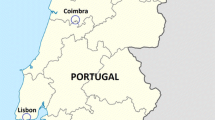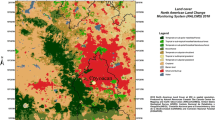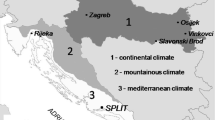Abstract.
A pollen calendar has been constructed for the area of Thessaloniki and relationships between pollen transport and meteorological parameters have been assessed. Daily airborne pollen records were collected over a 15-year period (1987–2001), using a Burkard continuous volumetric pollen trap, located in the centre of the city. Sixteen allergenic pollen types were identified. Simultaneously, daily records of five main meteorological parameters (mean air temperature, relative humidity, rainfall, sunshine, wind speed) were made, and then correlated with fluctuations of the airborne pollen concentrations. For the first time in Greece, a pollen calendar has been constructed for 16 pollen types, from which it appears that 24.9% of the total pollen recorded belong to Cupressaceae, 20.8% to Quercus spp., 13.6% to Urticaceae, 9.1% to Oleaceae, 8.9% to Pinaceae, 6.3% to Poaceae, 5.4% to Platanaceae, 3.0% to Corylus spp., 2.5% to Chenopodiaceae and 1.4% to Populus spp. The percentages of Betula spp., Asteraceae (Artemisia spp. and Ambrosia spp.), Salix spp., Ulmaceae and Alnus spp. were each lower than 1%. A positive correlation between pollen transport and both mean temperature and sunshine was observed, whereas usually no correlation was found between pollen and relative humidity or rainfall. Finally, wind speed was generally found to have a significant positive correlation with the concentrations of 8 pollen types. For the first time in the area of Thessaloniki, and more generally in Greece, 15-year allergenic pollen records have been collected and meteorological parameters have been recorded. The airborne pollen concentration is strongly influenced by mean air temperature and sunshine duration. The highest concentrations of pollen grains are observed during spring (May).




Similar content being viewed by others
Notes
The word "type" used in the text is a simple way to homogenize the botanical terms for pollen taxa (species, genera and families)
References
Annesi-Maesano I (1999) Epidemiological evidence of the occurrence of rhinitis and sinusitis in asthmatics. Allergy 54 [Suppl 57]:7–13
Blackley Ch (1988) On hay fever. Experimental researches. Oxford Historical Books, Abington
Bush R (1989) Aerobiology of pollen and fungal allergens. J Allergy Clin Immunol 64:1120–1124
D'Amato G, Lobefalo G (1989) Allergenic pollens in the southern Mediterranean area. J Allergy Clin Immunol 83:116–22
D'Amato G, Mullin J, Nolard N, Spieksma F, Wachter R (1988) City spore concentration in the European Economic Community. Oleaceae (Fraxinus, Ligustra, Olea). Clin Allergy 541–547
D'Amato G, Spieksma F Th, Liccardi G, Jager S, Russo M, Kontou-Fili K, Nikkels H, Wüthrich B, Bonini S (1998) Pollen related allergy in Europe. Allergy 6:567–578
Giner M, Selles (2002) Allergenic pollen in southest spain. Allergy 57:59–60
Gioulekas D, Chatzigeorgiou G, Spieksma F (1997) Allergenic pollen and pollinosis in northern Greece. In: D'Amato G, Spieksma F Th, Bonini S (eds) Allergenic pollen and pollinosis in Europe. Blackwell Scientific, Melburn- Paris Berlin Vienna, pp 167–171
Grigoreas C, Vourdas D (1996) Frequency of sensitization (positive skin prick tests) to inhaled pollen allergens in patients suffering from seasonal respiratory allergy (rhinoconjunctivits, asthma). Hell Allergol Clin Anosol 2:100–108
Horak F, Jäger S (1983) Grundlagen zur Allergenkarenz bei der Pollinose. Bluetezeiten und Pollentypen in Europa. Allergologie 113–118
International Rhinitis Management Working Group (1994) International consensus report on the diagnosis and management of rhinitis. Allergy 49 [Suppl 19]:1–34
Kaliner M, Lemanske R (1992) Rhinitis and asthma. JAMA 268:2807–2829
Kersten W, Puls K (1984) Pollenflug-Vorhersagen. Allergologie 81–114
Mandrioli P (1990) Aerobiology-pollen sampling, influence of climate, pollen sources and pollen calendar. In: Falagiani P (ed) Pollinosis. CRC, Boca Raton, Fla, pp 39–53
Mandrioli P, Negrini M (1991) Weather and climate in Europe. In: D'Amato G, Spieksma F Th, Bonini S (eds) Allergenic pollen and pollinosis in Europe. Blackwell Scientific, Melburn Paris Berlin Vienna, pp 3–17
Munn R (1970) Biometeorogical methods, degree days. In: Enviromental sciences Academic Press, New York, pp 155–163
Mygind N, Dahl R, Pedersen S, Thestrup-Pedersen K (1996) Essential allergy, 2nd edn. Blackwell Scientific, Melburn Paris Berlin Vienna, pp 3
Papageorgiou PS (1999) Particularities of pollen allergies in Greece. Pediatr Pulmonol Suppl 18:168–171
Rantio-Lehtimäki A (1991) Sampling airborn pollen and pollen antigens. In: D'Amato G, Spieksma F Th, Bonini S (ed) Allergenic pollen and pollinosis in Europe. Blackwell Scientific, Melburn Paris Berlin Vienna, pp 18–23
Sibbald B, Strachen D (1995) Epidemiology of rhinitis. In: Busse W, Holgate S (eds) Asthma and rhinitis. Blackwell Scientific, Boston, pp 32–34
Simons FR (1999) Allergic rhinobrochitis: the asthma – allergic rhinitis link. J Allergy Clin Immunol 104:534–540
Solomon W (1984) Aerobiology of pollinosis. J Allergy Clin Immunol 74:449–461
Spieksma F (1991) Regional European pollen calendars. In: D'Amato G, Spieksma F Th, Bonini S (eds) Allergenic pollen and pollinosis in Europe. Blackwell Scientific, Melburn Paris Berlin Vienna, pp 49–65
Spieksma F, Charpin H, Nolard N, Stix E (1980) City spore concentration in the European Economic Community. Summer weed pollen (Rumex, Plantango, Chenopodiaceae, Artemisia). Clin Allergy 319–329
Spieksma F, Van De Assem A, Collette B (1985) Airborne pollen concentration in Leiden, The Netherlands, 1977–1981. Poaceae (grasses), variations and relation to the hay fever. Grana 24:99–108
Spieksma F, Frenguelli G, Nikkels A, Mincigrucci G, Smithuis L, Bricchi E, Dankaart W, Romano B (1989) Comparative study of airborne pollen concentrations in central Italy and The Netherlands (1982–85). Emphasis on pollen Alnus, Poaceae, and Artemisia. Grana 28:25–36
Author information
Authors and Affiliations
Corresponding author
Rights and permissions
About this article
Cite this article
Gioulekas, D., Balafoutis, C., Damialis, A. et al. Fifteen years' record of airborne allergenic pollen and meteorological parameters in Thessaloniki, Greece. Int J Biometeorol 48, 128–136 (2004). https://doi.org/10.1007/s00484-003-0190-2
Received:
Revised:
Accepted:
Published:
Issue Date:
DOI: https://doi.org/10.1007/s00484-003-0190-2




